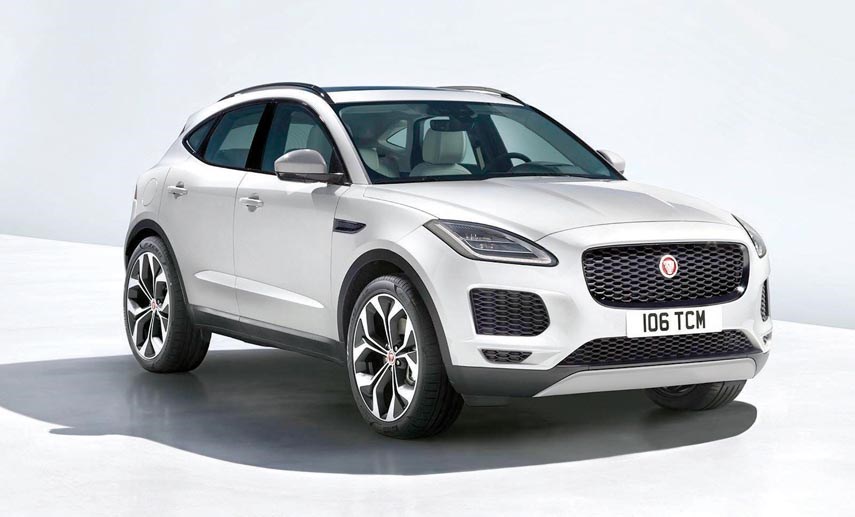Virtually all automakers have figured out that the key to current and future success lies with building utility wagons of varying sizes and descriptions.
That lesson hasn’t been lost on Jaguar. Beginning in early 2018, it will introduce the compact E-Pace as a junior partner to the mid-size F-Pace wagon that arrived for 2017.
The E-Pace name sounds like it might refer to an electric vehicle, but it uses good-old-fashioned gasoline propulsion. Jaguar’s upcoming 2019 I-Pace tall wagon will actually be the brand’s first electric.
What is unique about the E-Pace is that it rests on a front-wheel-drive platform derived from the Land Rover Evoque (Jaguar and Land Rover are owned by the same company). Like the F-Pace, however, the E-Pace has standard all-wheel drive.
The F-Pace and E-Pace are unmistakable as kin, right down to their similar looking front-end shapes that are clearly influenced by other Jaguar fleet members. The common thread also extends to the opposite end, where the fashionably sloping liftgate looks attractive enough, but results in reduced cargo space when compared to other, more squared-off designs.
The cabin appears equally inviting, especially the cockpit-style driver’s pod that could have been lifted straight out of the F-Type sports car. The touch screen is nice and big and the large, round ventilation controls will no doubt assist the fumble-fingered.
The E-Pace is more than a 30 centimetres shorter and about nine centimetres narrower than the F-Pace, but the real head scratcher is that the E-Pace actually outweighs the bigger Jag by 70 kilograms, which goes to show that compactness doesn’t necessarily result in a corresponding reduction in heft.
Fortunately the E-Pace is up to the task of quickly and efficiently hauling passengers and cargo, using a turbocharged 2.0-litre four-cylinder engine that’s rated at a respectable 247 horsepower and 269 foot-pounds of torque.
For significantly more oomph, the E-Pace’s R-Dynamic package comes with a turbo 2.0 that puts 296 h.p. and 295 foot-pounds of torque.
With either engine, a nine-speed automatic is the sole transmission choice.
The all-wheel-drive hardware depends on the engine, starting with a permanently engaged setup for base models. The R-Dynamic’s Active Driveline keeps only the front wheels turning in normal driving conditions. When traction loss is detected, the system can direct nearly all of the available torque to the rear axle and to a specific rear wheel, if necessary.
Active Driveline’s standard torque-vectoring system lightly applies the brakes to the inside wheel when cornering, which reduces the vehicle’s natural tendency to travel in a straight line even when the wheel is turned (called understeer).
Common to all E-Pace models is a low-speed cruise-control system that regulates the vehicle’s speed between two kilometres per hour and 30 km/h. Interestingly, active-safety technology such as blind-spot warning and adaptive cruise control are not standard, although lane-keeping assist is.
E-Pace pricing starts at $45,500, including delivery charges. For that pile of cash, you get a reasonable level of standard content, but to move closer to the luxury zone you’ll need to select the S or SE versions to get leather seat coverings, a panoramic roof, navigation, head-up info display and 18- or 19-inch wheels (17-inchers are standard).
Opting for the performance-laden R-Dynamic package adds about $8,300 to the base price, but you also get larger brakes plus a bit more comfort content along with the upgraded driveline. Atop the field is the E-Pace First Edition, available for 2018 only, that bundles up most of the extra-cost luxury options into one very complete trim level, but you’ll be in low-$60,000 territory.
Whatever the choice, the E-pace wagon appears to be an enticing little cat, with the looks, luxury and power that fits with the Jaguar name and reputation.
Market position
The E-Pace joins the legion of smaller premium utility vehicles, many of which are derivatives of midsize or larger tall wagons. In some cases, these models are replacing traditional sedans in their respective lineups.
Points
• Nicely balanced design presses all the right must-have buttons.
• Both base and higher-output versions of the turbo-2.0 engine should prove more than acceptable in the power department.
• Jaguar’s aversion to offering manual transmissions is unfortunate.
• Surprisingly heavy when compared to similarly sized wagons.
Active safety
Blind-spot warning with cross-traffic alert; active cruise control; emergency braking; lane-keeping assist (all optional).
Competition
Audi Q3 Quattro: Good-looking wagon is well priced. Quattro AWD is considered a top system. Base price: $39,500.
BMW X1 xDrive: Second-generation model uses the Mini Countryman platform. Can get pricey. Base price: $43,150.
Lexus NX: Less than subtle styling breaks from the pack. AWD Hybrid version available. Base price: $45,000.
wheelbasemedia.com



